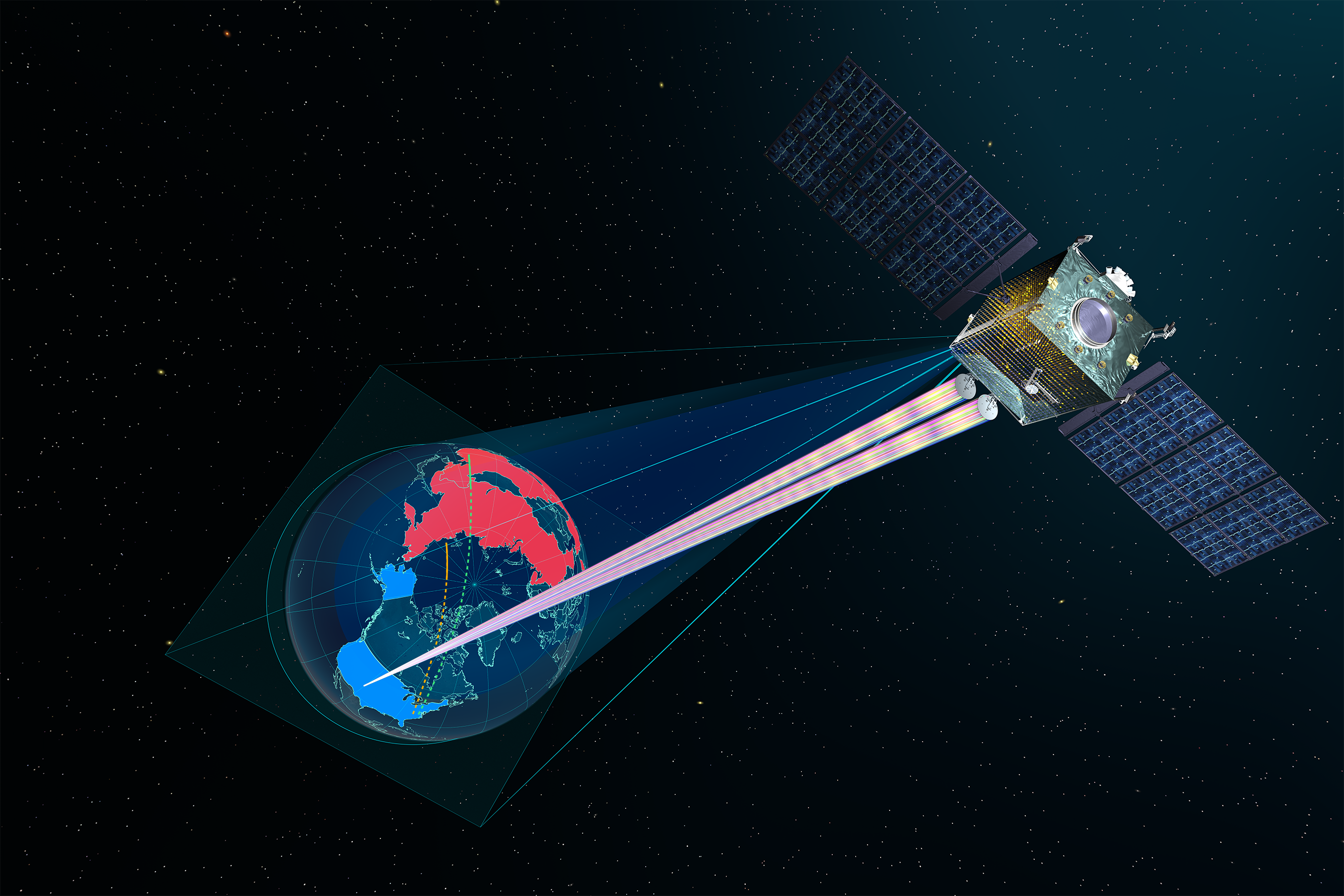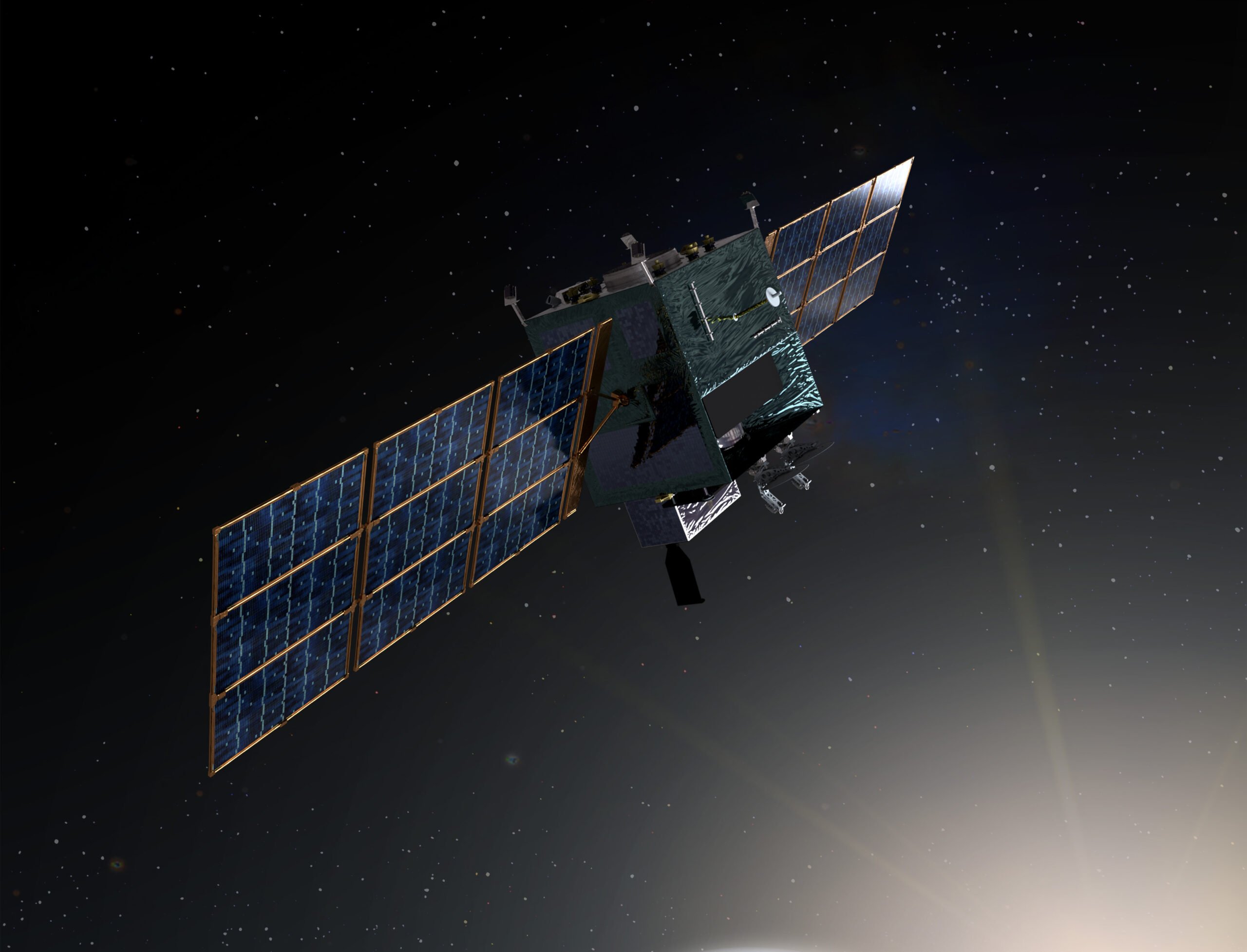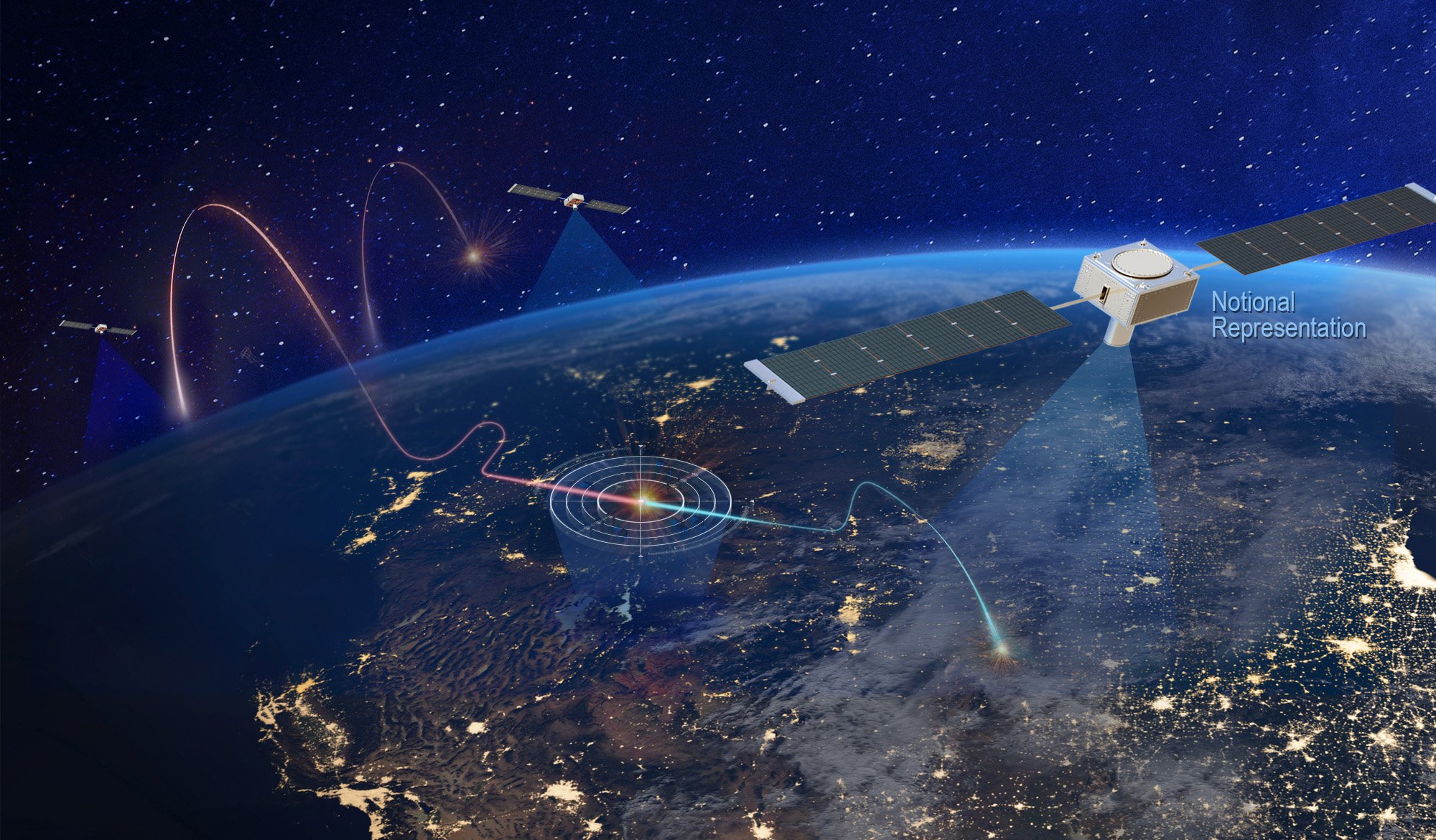
Two NGP satellites will provide precise, timely sensor coverage over the northern hemisphere to help defeat ballistic and hypersonic missiles. Image courtesy of Northrop Grumman.
Beginning mid-decade, Space Systems Command will begin to launch a new constellation of five ballistic missile early warning satellites known as the Next Generation OPIR satellites to augment the existing Space Based Infrared System (SBIRS) satellites.
Two of those OPIR satellites will be Next-Generation Polar (NGP) satellites in highly elliptical orbits, which will cover the northern polar region of the planet — the shortest route for a ballistic missile to be fired at the US. Under contract from the U.S. Space Force, the polar satellites are being designed and developed by Northrop Grumman, with the mission payloads for those two satellites being designed and developed by Northrop Grumman and Ball Aerospace. That same payload team will supply an additional OPIR payload for the Next-Generation Geo (NGG), which will all be stationed in geosynchronous orbit.
The NGP satellites act as a spotter, surveying an enormous swath of the Northern Hemisphere and sensing heat signatures from launching ballistic missiles from a highly inclined orbit averaging about 20,000 miles. Once spotted by NGP, the Hypersonic and Ballistic Tracking Space Sensor satellites (HBTSS), which will operate in low-earth orbit, will continuously track missiles to the end of the boost phase and hypersonic glide vehicles through their glide phase, and handoff precision tracking data to enable targeting of enemy missiles launched from land, sea, or air.
The HBTSS satellites will be cued by SBIRS, the Defense Support Program Satellites, and the Next-Generation Overhead Persistent Infrared system to detect and track missiles from their earliest stages of launch through interception.
In this Q&A on the OPIR program and Northrop Grumman’s role, we talk with Candace Givens, vice president, OPIR and Geospatial Systems, Strategic Space Systems, and Aaron Dann, vice president, Strategic Force Programs, Payload & Ground Systems.
Breaking Defense: What is it about the capabilities of today’s ballistic missile threats that require the US to develop a better OPIR system than we’re getting right now from SBIRS?
Givens: It’s a great thing to know that SBIRS is doing a phenomenal job, but what we want to make sure of is that as threats evolve and as hypersonic missiles come onboard, we are able to evolve our capability. Much of our payload development is making sure that we can look at larger areas on the globe, do that activity as quickly as possible, and get feeder information to support fire control targeting of that threat.
That improved capability comes from evolving the payload detection and tracking performance and its pointing agility, so it can see more challenging targets over a wider area by accurately steering where it looks.
There are more countries developing ballistic missile capability. The countries that already have ballistic missiles are increasing their inventory. China and Russia have added hypersonic capabilities to their ballistic forces.
We want to make sure that the US government maintains its position in protecting the nation and our allies as best we can. They’re looking to make sure there is no gap in capability and that we continue to evolve.
Dann: It’s important that we provide more advanced sensors going forward with the next-gen programs that will give our sensor systems greater sensitivity. Then, as we look at orbital diversity by going to low-earth orbit, medium-earth orbit, and geostationary orbit, these targets will essentially appear brighter because we’re closer to them, in addition to bringing other capabilities.
At the same time, it’s necessary that our current systems be very capable, and we continue to extract capability from them with our advanced processing. We’ve demonstrated over the years going back to DSP [Defense Support Program, a constellation of IR-sensor-equipped satellites for missile early warning beginning in the 1970s] that we launch these systems for a particular threat profile. Then, over time, we’re able to — through advanced processing and learning about what we can extract from our wide-band data streams — build capability against even some of these challenging, emerging targets.
I’ll note that all these missiles, whether they’re ballistic or hypersonic, start the same way — with a big bang. We see that and are extremely capable of providing warning with our current systems. Now it’s about addressing the more maneuverable threats to make sure that we can get the right data and the right predictions out to the warfighters to support their missions in the defense of our country and our allies.

As part of the Next Generation Overhead Persistent Infrared System (Next-Gen OPIR), two NGP satellites will provide precise, timely sensor coverage over the northern hemisphere to help defeat ballistic and hypersonic missiles. Graphic courtesy of Northrop Grumman.
Breaking Defense: You mentioned hypersonics, which brings the challenge of more maneuverable missiles to the conversation, along with more sophisticated countermeasures. How do you evolve OPIR sensors to see countermeasures, to see maneuverability, for example?
Givens: The evolution of what we’re doing in OPIR is having the ability to look at a larger area and getting a faster revisit rate with more or higher sensitivity on those sensors. We have assets coming online that not only see the booster — we already have that — but track it and make sure that if it maneuvers or does other things we’re still able to figure out where it’s going and then send that message to the next level so that they can intercept and defeat the threat.
We’re seeing a combination of capabilities coming. We’re evolving the sensors, as I mentioned, and to Aaron’s point, we’re hitting it from multiple layers with the Next-Generation Polar satellites and HBTSS to make sure that we have a full line of defense, and that the DoD can actually defeat the threat before it has an impact on any US target.
Dann: We’re in a different threat environment than when we designed DSP and SBIRS. Our payloads are being built to be able to counter or operate through the threat. Candace mentioned faster revisit rates and higher sensitivity. We can also process onboard, bring higher sensitivities forward, and get that information out. Our ground processing will work in conjunction across these assets to make the right decisions and infer the right actions to counter what may be happening from our adversaries. As Candace said, it’s not going to be a single payload or single orbit that’s going to do everything for us.
The space vehicle itself will also give us additional capabilities beyond the OPIR payload. Take the Polar satellites, for example. Given the orbit the satellites are in, they’re naturally more resilient systems. And critically, they have the ability to continue to downlink their comms into CONUS and mitigate jamming.
Givens: It’s a multi-pronged approach to resiliency in that it’s more than the IR payloads or the comm payloads to defend against jamming. It’s also: “What can we do onboard, with the quantity of satellites that we fly, and with orbit diversity?” We’re looking at the architecture from multiple fronts.
We’re making sure we can help the government on all levels in all orbital regimes to make sure that their architecture comes to fruition.

HBTSS satellites will provide continuous tracking and handoff to enable targeting of enemy missiles launched from land, sea, or air. They are a critical part of the Overhead Persistent Infrared (OPIR) multi-layered constellation of satellites, which can sense heat signatures to detect and track missiles from their earliest stages of launch through interception. Graphic courtesy of Northrop Grumman.
Breaking Defense: What are your milestones and roadmap?
Givens: With the HBTSS program, we were able to get to CDR [Critical Design Review] in eight months. If you look at where the customer acquisition philosophy is going, they’ve been very vocal about how we need to do things quicker and still provide that mission capability. HBTSS is a great example of that because we were able to get to CDR so quickly. We’re going to deliver our HBTSS prototype in 2023.
Another example is what we’re doing with the Tracking Layer Tranche 1 effort. [This is a Space Development Agency constellation that would comprise approximately 28 satellites in Low Earth Orbit optimized for use by Indo-Pacific Command to monitor Chinese and North Korean missile launches.] We’re building 14 satellites to fly in a LEO orbit for the proliferated OPIR mission. We’ve already had a successful System Requirements Review.
Also happening are the Next-Gen GEO and Next-Gen Polar programs, so we’re making great progress across the board at all levels. There are a lot of great things that are happening right now in OPIR.
We understand that there are many missile threats out there and that they’re evolving. We’ve positioned ourselves to help the government figure out what that next-gen architecture needs to be. We want to partner with the government to figure out how we address all the threats and make sure that we have payloads that service those solutions, and the holistic ground and space solutions that service their needs.
Dann: Here at Northrop Grumman we understand this threat, as Candace said, but also, we have many dedicated people that have spent their careers in this mission space. Going back more than 60 years, some of the earliest OPIR experiments were done out of our Azusa, CA, facility, which is now part of Northrop Grumman.
Our people are dedicated to this mission, they understand it, and they want to ensure that we succeed with minimal risk. This is a no-fail mission. That’s how we talk about it. That’s how we address it.
As we look forward to these emerging architectures, we want to make sure that we are doing it with an evolutionary approach. At the same time, missile warning is an area where we’re unwilling to create any risk for our customer and our country. We’re leveraging proven solutions like NGP. We deliver to that orbit. We understand that orbit well.





















